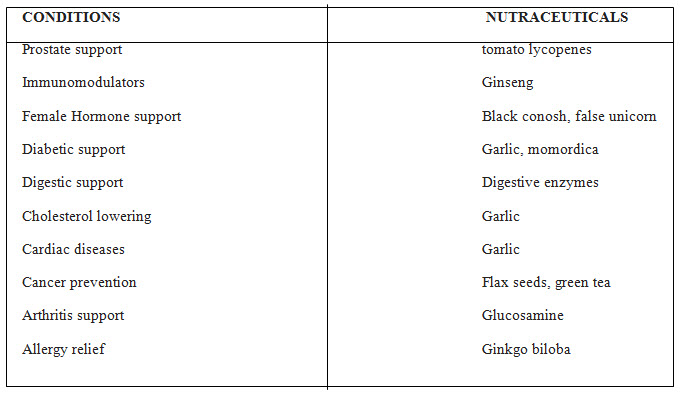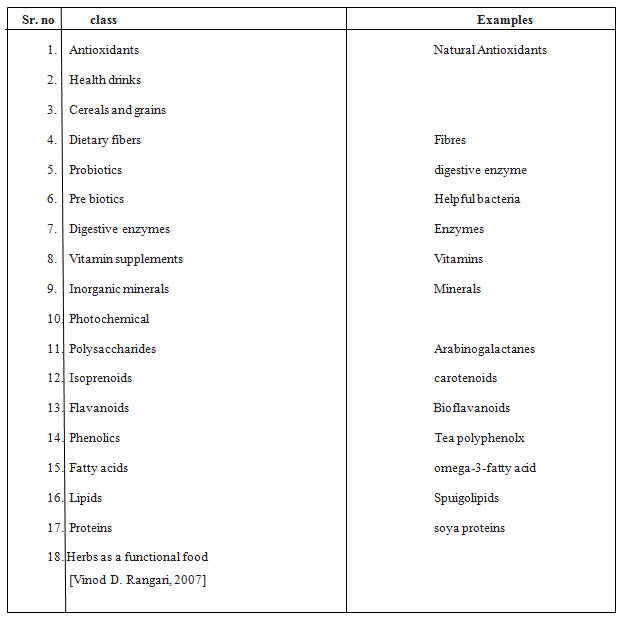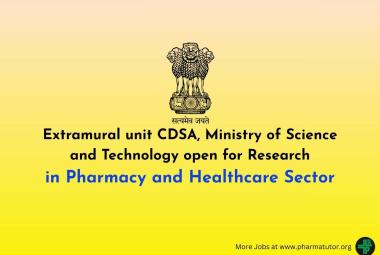ABOUT AUTHORS
Abhishek Kumar*, Sandhya Singh, Rajesh Kumar, Pankaj Maurya, Devendra Nath
Department of Pharmacy
Ashoka Institute of Technology and Management,
Varanasi, U.P., India
{ DOWNLOAD AS PDF }
ABSTRACT
Nutraceutical from Nutrition and Pharmaceutical, in 1989. Nutraceuticals refers to foods having a medicinal effect on health of human beings. It consist of food supplements, herbal products, probiotics and prebiotics, medical foods meant for prevention and treatment of diseases. Major nutraceuticals posses multiple therapeutic effect with lacking of unwanted effects. A nutraceutical is demonstrated to have a physiological benefit or provide protection against chronic disease. I try to redefine functional foods and nutraceuticals. When food is being cooked or prepared using scientific intelligence with or without knowledge is called functional food. Thus, functional food provides the body with the required amount of vitamins, fats, proteins, carbohydrates, etc, needed for its healthy survival When functional food aids in the prevention, treatment of disease(s) and disorder(s) other than anemia, it is called a nutraceutical. Nutraceuticals are non toxic food components which claimed to possess multiple therapeutic benefits. Some popular nutraceuticals include glucosamine, ginseng, echinacea, folic acid, cod liver oil, omega-3 fatty acid(MUFA,PUFA), calcium-enriched orange juice, green tea, plant phenols etc.
Reference Id: PHARMATUTOR-ART-2599
INTRODUCTION
"Nutraceutical" was coined from "nutrition"and "pharmaceutical" in 1989 by Stephen Defelice, MD, founder and chairman of the Foundation for Innovation in Medicine (FIM), Cranford, NJ. According to him, nutraceutical can be defined as, "a food that provides medical or health benefits, including the prevention and/or treatment of a disease." [Brower V., 1998]. Today, Nutraceutical in market consist of both traditional food and non traditional food.
Traditional food: Consist of natural, whole foods with new information about their potential health qualities, no change to actual foods. Example: lycopene in tomatoes, omega-3fatty acids in salmon.
Non traditional food: Resulting from agricultural breeding or added nutrients and ingredients, that is to boost their nutritional values. Example – β carotene enriched rice and soybeans. Cereals with added vitamins or minerals, orange juice fortified with calcium, cereals with added vitamins and minerals [Neutraceuticals. Aboutbioscience. Org.2007.]
Dietary supplement: FDA regulates both finished dietary supplement products and dietary ingredients. FDA regulates dietary supplements under a different set of regulations than those covering "conventional" foods and drug products. Under the Dietary Supplement Health and Education Act of 1994 (DSHEA):
• Manufacturers and distributors of dietary supplements and dietary ingredients are prohibited from marketing products that are adulterated or misbranded. That means that these firms are responsible for evaluating the safety and labeling of their products before marketing to ensure that they meet all the requirements of DSHEA and FDA regulations.
• FDA is responsible for taking action against any adulterated or misbranded dietary supplement product after it reaches the market.
Examples:
• Yogurts - Probiotics for intestinal health.
• Foods/cereals/snacks enriched with s oluble fibres, vitamins and minerals.
• Omega-3 milk in prevention of heart disease
• Canola oil with lowered triglycerides for cholesterol reduction
• Oats, bran, ps yllium and lignin's fo r heart disease and colon cancer
• Prebiotics - oligofructose for control of in testinal flora
• Stanols (Benecol) in reduction of cholesterol adsorption
Medicinal Foods:
• Health bars with added medications
• Transgenic cows and lacto-ferrin for immune enhancement
• Transgenic plants f or oral vaccinatio n against infectious diseases
A Nutraceutical is a pharmaceutical-grade and standardized nutrient.[ Sarris et al.,2016] In the US, "nutraceuticals" do not exist as a regulatory category; they are regulated as dietary supplements and food additives by the FDA under the authority of the Federal Food, Drug, and Cosmetic Act.
Indian, Egyptians, Chinese and Sumerians are just a few civilizations that have used foods medicine. [Wildman and Robert E. C., ed. (2001).] “Let food be the medicine “ is a common misquotation[Cardenas and Diana (2013). ] attributed to Hippocrates, who considered by some to be the father of western medicine. Nutraceutical is a combination of two words [Juan Carlos]
1. Nutrional and
2. Pharmaceutical.
2. Classification of nutraceuticals.
Regarding to nutraceuticals, they should be considered in two ways.
Nutraceuticals
1.Potential nutraceuticals
2.Stablised nutraceuticals
Classification of neutraceuticals based upon it therapeutical implications for treatment or prevention of Specific condition.
They are specially directed for its treatment, prevention or support are given in table-1
Table-1 Nutraceuticals used in various disease conditions

Classification on the bases therapeutically important compounds of the neutraceuticals products responsible for the health benefit as shown in table-2 [Vinod D. Rangari, 2007]

Role of Research and Development in nutraceuticals
• To test safety, purity and potency of products.
• To develop more effective and efficient means of producing ingredients for use in products.
• To develop testing methods for ensuring and verifying the consistency of the dosage of ingredients included in the company’s products.
• Develop the new products either by combining existing ingredients used in nutritional supplements or identifying new ingredients.
Nutraceutical use in some diseases
Glucosamine and Chondroitin
Glucosamine is a precursor to a molecule called a glycosaminoglycan-this molecule is used in the formation and repair of cartilage. Source-bovine or calf cartilage.Glucosamine sulphate in several.European countries used as first line of treatment for arthritis. There side effects and contraindications are less but diabetics need to be careful as glucosamine might have an effect on insulin resistance. Glucosamine sulphate stimulates the production of hyaluronic acid in joint fluid. Hyaluronic acid relieves pain and improves mobility by repairing particularly fermented milk products, orhave been investigated with regard to their medicinal use.
In vitro experiment of Glucosamine has shown a dose dependent increase in proteoglycan after administering it. It is marketed usually as hydrochloride or sulfate salt. Both compounds have anti inflammatory effects. [European Food Safety Authority, 2008]
Chondroitin-is glycosaminoglycan in cartilage that is responsible for resiliency of cartiliage.
Methylsulfonyl Methane:
MSM used as nutritional and dietary supplement used in combination with glucosamine and Chondroitin. Both compound used for pain and inflammation.MSM is the source of sulphur for the formation of the cartilage matrix or the antioxidant system [European Food Safety Authority, 2008]
China is grown commercially for its seeds rich in-α linolenic acid.
NOW YOU CAN ALSO PUBLISH YOUR ARTICLE ONLINE.
SUBMIT YOUR ARTICLE/PROJECT AT editor-in-chief@pharmatutor.org
Subscribe to Pharmatutor Alerts by Email
FIND OUT MORE ARTICLES AT OUR DATABASE
Alpha- linolenic acid (ALA):
α-Linolenic acid (ALA) is an n−3 fatty acid. It is one of two essential fatty acids.They cannot be produced within the human body, must be required through diet. ALA is an omega-3 fatty acid found in seeds (chia, flaxseed, hemp). Nuts (walnuts), and many common vegetable oils. Its structure, it is named all-cis-9,12,15-octadecatrienoic acid.[ Beare-Rogers (2001).]
ALA % in the table below refer to the oils extracted from each item.
|
Common name |
Alternate name |
Linnaean name |
% ALA (of oil) |
|---|---|---|---|
|
Chia |
chia sage |
Salvia hispanica |
64% |
|
Kiwifruit seeds |
Chinese gooseberry |
Actinidia chinensis |
62% |
|
Perilla |
shiso |
Perilla frutescens |
58% |
|
Flax |
linseed |
Linum usitatissimum |
55% |
|
Lingonberry |
cowberry |
Vaccinium vitis-idaea |
49% |
|
Camelina |
camelina |
Camelina sativa |
35-45% |
|
Purslane |
portulaca |
Portulaca oleracea |
35% |
|
Sea buckthorn |
seaberry |
Hippophae rhamnoides L. |
32% |
|
Hemp |
cannabis |
Cannabis sativa |
20% |
|
Walnut |
English walnut / Persian walnut |
Juglans regia |
10.4% |
|
Rapeseed |
canola |
Brassica napus |
10% |
|
Soybean |
soya |
Glycine max |
8% |
Probiotics, Prebiotics and Synbiotics
In Probiotics, according to a consensus definition, are ‘living micro-organisms, which upon ingestion in certain numbers, exert health benefits beyond inherent basic nutrition[Terry P et al., 2001, Hanif R et al., 2006]’,but alternatively probiotics are loosely known as live microorganisms belonging to natural biota with low or no pathogenicity, but with functions of importance to the health and well being of the host.[ Akubugwo IE et al., 2007, Eamonn MM ] Some Probiotic microorganisms such as Lactobacillus rhamnosus GG, Lactobacillus reuteri, bifidobacteria and some certain strains of Lactobacillus casei, the Lactobacillus acidophilus-group, Escherichia coli strain Nissle 1917, certain enterococci, especially Enterococcus faecium SF68, and the probiotic yeast Saccharomyces boulardii) mostly used in probiotic food, that are fermented milk products. New genera and strains of probiotics are emerging; some with high health benefits as in Lactobacillus plantarum isolates (PCS20, PCS22, PCS25 and PCS26) from Slovenian cheese with high antimicrobial and immunomodulatory capabilities. An international expert group of the International Life Sciences Institute (ILSI) has evaluated the categorized and published evidence of functionality of different probiotics in four areas of (human) application.
(i)Metabolism, (ii) Chronic intestinal inflammatory and functional disorders, (iii) Infections, and (iv) Allergy. [Eamonn MM], Probiotic have been shown to have applications in alleviating symptoms of allergies, cancer, AIDS ,respiratory and urinary tract infections.
A prebiotic is a selectively fermented ingredient or a fibre that allows specific changes ,both in the composition and activity of the gastro intestinal microflora.
A specific effects of prebiotics on health are indirect,namely prevention of diarrhea or obstipation,modulation of the metabolism of the intestinal flora,cancer prevention and effects on lipid metabolism.
Today,only bifidogenic,nondigestable oligosaccharides that fulfill all the criteria for prebiotic classification[Christina S Venter, 2007.]
Probiotics and prebiotics share unique role in human nutrition,but they are largely centre on manipulation of populations or activities of the microbiota that colonize the human GI tract.[ Akubugwo IE et al., 2007]
Fructosan,insulin that is obtained from Jerusalem artichoke tubers,Helianthus tuberosus,family composiate or raw chicory is the best known prebiotics.
Food supplements such as fructo-oligosaccharides,(FOS) that have more long lasting effectas they encourage the growth of Bifidobacteria, that is largely present in the gut.[ Dr. Vinod D. Rangari] 10g of FOS is needed daily.
Micronutrients and Micronutrients
Vitamins:-
Deficiency of any kind of vitamins can cause distinguishable clinical symptoms.some nutraceuticals or nutritional therapy products contain some vitamins,such as vitamin A,vitamin Bs ,vitamin C ,vitamin D and vitamin E.
Large portion of vitamin sources in human is from plant foods.
“Golden rice” a transgenic rice with a high level of the provitamin A betacarotinoid in its grains.
Today ,with the golden rice-absorption studies is being carried with out with humans,to taste the efficiency of absorption and conversion of beta carotene into vitamin A .
Synthesis of both foliate (vitamin B11) and riboflavin(vitamin B2) are synthesized by Lactococcus lactis.
Vitamin C is essential to prevent disease associated with connective tissue and to improve cardiovascular and immune cell functions.
Minerals: - deficiency of minerals make a serious health problems.Ca, I, Zn, Fe, Mn, etc. are essential components for human health’s.
Mineral deficiency may generally cause inn infants and in children’s. Ca, Zn, Fe, and other minerals are taking from both meats and plant foods.
The limit of effectiveness of these supplements such as dietary habits, lipids and vitamins cofactors, or minerals-minerals interactions during absorption.
Health status of individuals, can also influence there absorption. Neverthlesness , increasing dietary Ca, Fe and Zn in plant. Foods is an important strategy to enhance mineral nutrition. [Tuohy K et al., 2002]
Flavonoids:
Tomatoes contain high level of flavonols such as quercetin ,kaempherol and glycosides and some flavones such as luteolin, lycopene and luteolin-7-glycosides in there peel tissue,the level of resveratrol in brassica napus seed also increased. Flavonoids are absorbed from gastro intestinal tract of human and animal and excreted either unchanged or as flavinoid metabolites in the urine and feaces.[ Tuohy K et al., 2002]
Terpenoids:
Terpenoids are the most diverse and largest class of plant natural products with wide industrial application, a provitamin A, vitamin E, flavors, pharmaceuticals, perfumes, insecticides, and anti-microbial agent Epidemiological studies have clearly shown the great benefits of consumption of tomato to human health due to tomato carotenoids, mainly lycopene, b- carotene, and lutein.[ Tuohy K et al., 2002]

Nutraceuticals and diseases:
Nutraceuticals against Alzheimer's disease (AD)
Alzheimer's disease (AD), also called senile dementia of the Alzheimer type (SDAT), primary degenerative dementia of the Alzheimer's type (PDDAT), or simply Alzheimer's, is the most common form of dementia. The various nutraceuticals which are used to cure Alzheimer's disease is as follow:- Antioxidants Antioxidants are very essential in the treatment of almost all diseases because most chronic diseases carry with them a great pact of oxidative stress. Oxidative stress plays a chief job in neurodegenerative diseases such as Alzheimer's disease (AD), Parkinson's disease (PD), and Huntington’s disease (HD). Oxidative stress is accelerated by the ageing process along with lack of dietary antioxidants. A huge number of studies have found an association between high dietary antioxidant intake and a decreased risk of AD which is very imperative because preventing a disease is significantly easier than treating it. So prevention is key and researches suggest that preventing AD is actually not that complex. Treatment with antioxidants is a hopeful loom for slowing disease progression. There is an ongoing study with vitamin E to see if it really slows AD progression. An assessment was done by isolating the patients into two groups one is treated with 1000 IU of vitamin E and at least 5 mg of donepezil (Aricept) and the other who did not take any vitamin E. Consequences showed that those taking the permutation therapy declined at a drastically lower rate. Food utilization studies have had similar outcomes. There are plentiful antioxidants in food, you get a surplus of them – everything from flavonoids to well known antioxidants like vitamin E and vitamin C.
[ Klatte ET, et al., 2003]
Cardiovascular diseases:
Worldwide, the burdens of chronic diseases like cardiovascular diseases, cancers, diabetes and obesity is rapidly increasing. In 2001, chronic diseases contributed approximately 59% of the 56.5 million total reported deaths in the world and 46%of the global burden of disease. Cardiovascular diseases (CVD) is the name for the group of disorders of the heart and blood vessels and include hypertension (high blood pressure), coronary heart disease (heart attack), cerebrovascular disease (stroke), heart failure, peripheral vascular disease, etc. In 1999 CVD alone contributed to a third of global deaths and by 2010 it would be the leading cause of death in developing countries. Majority of the CVD are preventable and controllable. It was reported that low intake of fruits and vegetables is associated with a high mortality in cardiovascular disease. [Rissanen TH et al., 2003, Temple WJ and Gladwin KK, 2003]. Many research studies have identified a protective role for adiet rich in fruits andvegetables against CVD[Hu FB and Willett WC, 2002] . This apart, nutraceuticals in the form of antioxidants, dietary fibers, omega-3 polyunsaturated fatty acids (n-3 PUFAs), vitamins, and minerals are recommended together with physical exercise for prevention and treatment of CVD. It has been demonstrated that the molecules like polyphenols present in grapes and in wine alter cellular metabolism and signalling, which is consistent with reducing arterial disease [German JB and Walzem RL, 2000]. Flavonoids are widely distributed in onion, endives, cruciferous vegetables, black grapes, red wine, grapefruits, apples, cherries and berries. [Hollman PCH et al., 1996] Flavanoids in plants available as flavones (containing the flavonoid apigenin found in chamomile); flavanones (hesperidins - citrus fruits; silybin- milk thistle flavonols (tea: quercetin, kaempferol and rutin grapefruit; rutinbuckwheat; ginkgo flavonglycosides - ginkgo)[ Majoa, DD et al., 2005] play a major role in curing the cardiovascular diseases[Cook NC and Samman S, 1996, Hollman PCH et al., 1999] . Flavonoids block the angiotensin-converting enzyme (ACE) that raises blood pressure; by blocking the "suicide" enzyme cyclooxygenase that breaks down prostaglandins, they prevent platelet stickiness and hence platelet aggregation. Flavonoids also protect the vascular system and strengthen the tiny capillaries that carry oxygen and essential nutrients to all cells.
Parkinson's disease:
Parkinson’s disease is a brain disorder that results from nerve damage in certain regions of the brain causing muscle rigidity, shaking, and difficult walking [Losso JN, 2003] usually occurring in mid to late adult life. Canadian researchers indicated that vitamin E in food may be protective against Parkinson's disease. [Latif S et al., 2007]Creatine appeared to modify Parkinson’s disease features as measured by a decline in the clinical signs. [Brower V, 2005] Researchers have also studied glutathione to determine its effect on nerve and its power as an antioxidant. The appropriate long-term dosing, side-effects and the most effective method of administration are not yet clear. Nutritional supplements have shown some promising results in preliminary studies, it is important to remember that there is not sufficient scientific data to recommend them for Parkinson's disease at present. The patients should be cautioned that over-thecounter medications do have side effects and interactions with other drugs and are also expensive.
Obesity
Obesity is a complex condition, with serious social and psychological dimensions, affecting virtually all ages and socioeconomic groups. The worldwide existence of obesity nearly doubled between 1980 and 2008. [World Health Organization] According to country estimates for 2008, over 50% of both men and women in the WHO European Region were overweight, and roughly 23% of women and 20% of men were obese.[ World Health Organization]Given the worldwide increase in obesity and its health consequences, efficient strategies for its prevention and treatment are important. It has been recommended that weight reduction programs focus on achieving a modest weight loss of 7–10% of the initial weight [Grundy SM et al., 2005]
Prevention or Treatment — requires modification of one or both components of energy balance. Approaches to weight management (including a functional food approach) therefore can target multiple aspects of the energy balance systems: food intake, energy expenditure, and energy storage. All of these approaches are currently being taken by pharmaceutical companies; however, developing functional foods designed for weight management may be a more attractive approach for dealing with the 61% of the population that is currently overweight or obese. [Hil JO and Peters JC, 2002]
In Apoptosis and Disease
Prevention It has been suggested by various epidemiological and animal model studies that nutraceuticals, mostly photochemical derived from nutritional or medicinal plants such as tea, garlic, ginger, soya bean and others may have chemo preventive activity. Their mechanism of reducing cancer incidence in these studies is closely related to apoptosis. There is a vast amount of information in the literatures, which supports the effects of nutraceuticals in cultured human cells, specifically in apoptosis. In this section, we review effects of some selected photochemical that belong with the following structural classes: carotenoids, flavonoids, stilbenes, or other sulphur-containing compounds. [Alexander G, Kuang YC, 2004]
NOW YOU CAN ALSO PUBLISH YOUR ARTICLE ONLINE.
SUBMIT YOUR ARTICLE/PROJECT AT editor-in-chief@pharmatutor.org
Subscribe to Pharmatutor Alerts by Email
FIND OUT MORE ARTICLES AT OUR DATABASE
CONCLUSION:
Currently, due to the lack of enough knowledge about usage, outcome, and safety of many nutraceuticals, phytonutrients as well as their corresponding therapies, many efforts have been put on these studied. However,
from many aspects of nutritional value including quality and quantity, our food is very limited in supplying adequate nutrients for human being, as indicated by an investigation.
REFERENCES
1. Akubugwo IE et al., (2007), Nutritional and chemical value of Amaranthus hybridus leaves from Afikpo, Nigeria. African Journal of Biotechnology. ;6(24):2833-2839
2. Alexander G, Kuang YC, (2004), Nutraceuticals, Apoptosis, and Disease Prevention. Nutrition; 20(1) :95–102
3. Beare-Rogers (2001), "IUPAC Lexicon of Lipid Nutrition" (pdf). available at: https://infobardiamond.azurewebsites.net/Library/Feeds/Articles/LexiconOfLipidNutrition.pdf (Archived PDF from the original on 12 February 2006. Retrieved 22 February 2006)
4. Brower V., (1998) Nurtraceuticals: poised for health slice of the healthcare market? Nat biotechnology.;16(8) : 728-731.
5. Brower V, (2005), A nutraceutical a day may keep the doctor away. EMBO reports.; 6(8): 708–711
6. Cardenas and Diana (2013). “Let not thy food be confused with thy medicine: The Hippocratic misquotation” ; 8 (6) : 260-262
7. Cook NC and Samman S, (1996) Flavonoids - Chemistry, metabolism, cardioprotective effects, and dietary sources. J. Nutritional Biochem.;7(2) : 66-76.
8. Christina S Venter, 2007. Prebiotics: an update Journal of Family Ecology and Consumer Sciences.; 35(1): 17-25.
9. Dr. Vinod D. Rangari book (2009) “Pharmacognosy & Phytochemistry” part-II ; Career Publication; Nashik
10. Eamonn MM Quigley (2010); Review On Prebiotics and probiotics; modifying and mining the Microbiota ; Pharmacological Research; 61(3); 213-218
11. EFSA (European Food Safety Authority). Scientific Opinion of then Panel on Dietetic Products, Nutrition and Allergies on a request from the EC on Food-Based Dietary Guidelines. The EFSA J. 2008:1-44.
12. German JB and Walzem RL, (2000) The health benefits of wine. Annual Review of Nutrition.; 20(7):561- 593.
13. Grundy SM et al., (2005) : Diagnosis and management of the Metabolic syndrome: an American Heart Association/National Heart, Lung, and Blood Institute Scientific Statement. Circulation; 112: 2735-52.
14. Hanif R et al. (2006); Use of vegetables as nutritional food: role in human health. J Agric.Boil Sci.;1:18.
15. Hil JO and Peters JC, 2002: Biomarkers and functional foods for obesity and diabetes. Br J Nutr ;88(2):213–18.
16. Hollman PCH et al., (1996) ; Analysis and health effects of flavonoids, Food Chem.; 57(1) : 43- 46.
17. Hollman PCH et al., (1999) Tea flavonols in cardiovascular disease and cancer epidemiology. Proc Soc Exper. Biol. Med.; 220(4) : 198-202.
18. Hu FB and Willett WC, (2002) ; Optimal diets for prevention of coronary heart disease. JAMA.; 288(20): 2569-2578.
19. Juan Carlos Espı´n, Marı´a Teresa Garcı´a-Conesa and Francisco A. Toma´s-Barbera´n. Nutraceuticals: Facts and fiction.
20. Klatte ET, et al., (2003) Combination therapy of donepezil and vitamin E in Alzheimer disease. Alzheimer Dis Assoc Disord; 17(2): 113-116
21. Labeling & Nutrition”. The Food and Drug Administration, US Department of Health and Human Services. 5 October 2016. Retrieved 2016-10-11.
22. Latif S et al., (2007) Moringa oleifera: a food plant with multiple medicinal uses. Phytother Res.; 21(1) : 17-25.
23. Losso JN, (2003) Targeting excessive angiogenesis with functional foods and nutraceuticals Trends in Food Science and Technology.; 14(11) : 455-468.
24. Majo, DD et al., (2005) Flavanones in Citrus fruit: Structure–antioxidant activity relationships. Food Research Int.; 38(10):1161-1166.
25. Neutraceuticals. Aboutbioscience. Org.2007.https://docs google.com/viewer ?a=v&q=cache:n2B hd6DAtggJ: www.aboutbioscience.org/pdfs/ Neutraceuticals.
26. Rissanen TH et al., (2003) Low Intake of Fruits, Berries and Vegetables Is Associated with Excess Mortality in Men: the Kuopio Ischaemic Heart Disease Risk Factor (KIHD) Study. J Nutr.; 133(1) : 199-204.
27. Sarris et al., (2016); “Adjunctive Nutraceuticals for Depression: A Systematic Review and Meta- Analyses”. American Journal of Psychiatry. 173 (6) :575-87.
28. Temple WJ and Gladwin KK, (2003) Fruits, vegetables, and the. Prevention of cancer: Research challenges. Nutrition.; 19(5) : 467-470.
29. Terry P et al., (2001). Fruit, vegetables, dietary fiber, and risk of colorectal cancer. J Natl Cancer Inst.;93(7): 525-533.
30. Tuohy K et al., 2002 Prebiotic effects of inulin and oligofructose, Food Microbial Sciences Unit, School of Food Biosciences, The University of Reading, Whiteknights, Reading,RG6 6AP, UK British Journal of Nutrition.;87(2):193–197.
31. Wildman and Robert E. C., ed. (2001). Handbook of Nutraceuticals and Functional Foods (1st ed.). CRC Series in Modern Nutrition.
32. World Health Organization. Global Strategy on Diet, Physical Activit Health2010.https://www.who.int/dietphy sicalactivity/publications/facts/obesity/en/.
|
PharmaTutor (Print-ISSN: 2394 - 6679; e-ISSN: 2347 - 7881) Volume 6, Issue 8 Received On: 23/11/2017; Accepted On: 06/07/2018; Published On: 01/08/2018 How to cite this article: Singh, S., Kumar, A., Kumar, R., Maurya, P. and Nath, D. 2018. Nutraceutical: A New Scope and Opportunity of Healthcare. PharmaTutor. 6, 8 (Aug. 2018), 9-16. DOI:https://doi.org/10.29161/PT.v6.i8.2018.9 |
NOW YOU CAN ALSO PUBLISH YOUR ARTICLE ONLINE.
SUBMIT YOUR ARTICLE/PROJECT AT editor-in-chief@pharmatutor.org
Subscribe to Pharmatutor Alerts by Email
FIND OUT MORE ARTICLES AT OUR DATABASE









